Collecting and Display at Dorich House
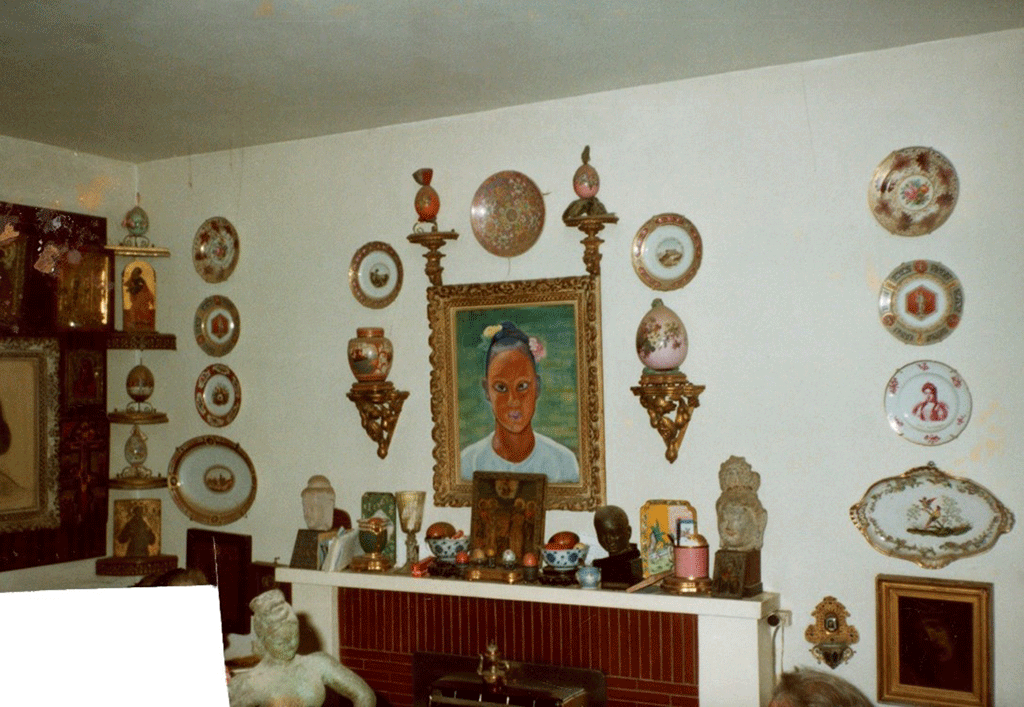
What do some decorative wall brackets sold at auction in 1994 tell us about plans Dora Gordine and Richard Hare had for the future of Dorich House? Here volunteer Nadia Stern takes these modest items as a starting point for a wider exploration of the collection and the couple’s dream of the house as a museum of imperial Russian art.
The below photograph of nineteenth-century decorative wall brackets, designed to display cherished objects, is from a catalogue for a sale by Phillips Auctioneers in London in 1994 of ‘19th Century & Decorative Furniture, Sculpture, Carpets and Works of Art’. These wall brackets formed a tiny portion of hundreds of lots sold at auction in the mid-1990s that once comprised the contents of Dorich House, which were sold to fund its renovation after the death of Dora Gordine (1895–1991). There is inevitably something poignant about posthumous sales, doubly so in this case as some of the items once carefully displayed on the wall brackets may also have formed part of the sale. Numbered and precisely arranged, the brackets are shown empty of the objects they would once have carried. Reminiscent of police records of crime scenes, the image also evokes the burglary in 1988 that so devastated Dora because it undermined her efforts to secure the future of Dorich House as a museum.[1] It is a sad reminder that Dora Gordine and Richard Hare’s (1907–1966) ambition to gift Dorich House and its contents to the nation was only fulfilled after their deaths.
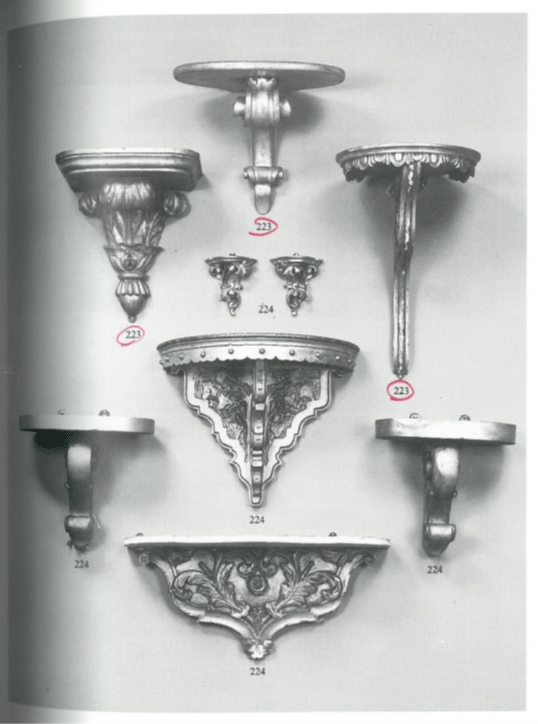
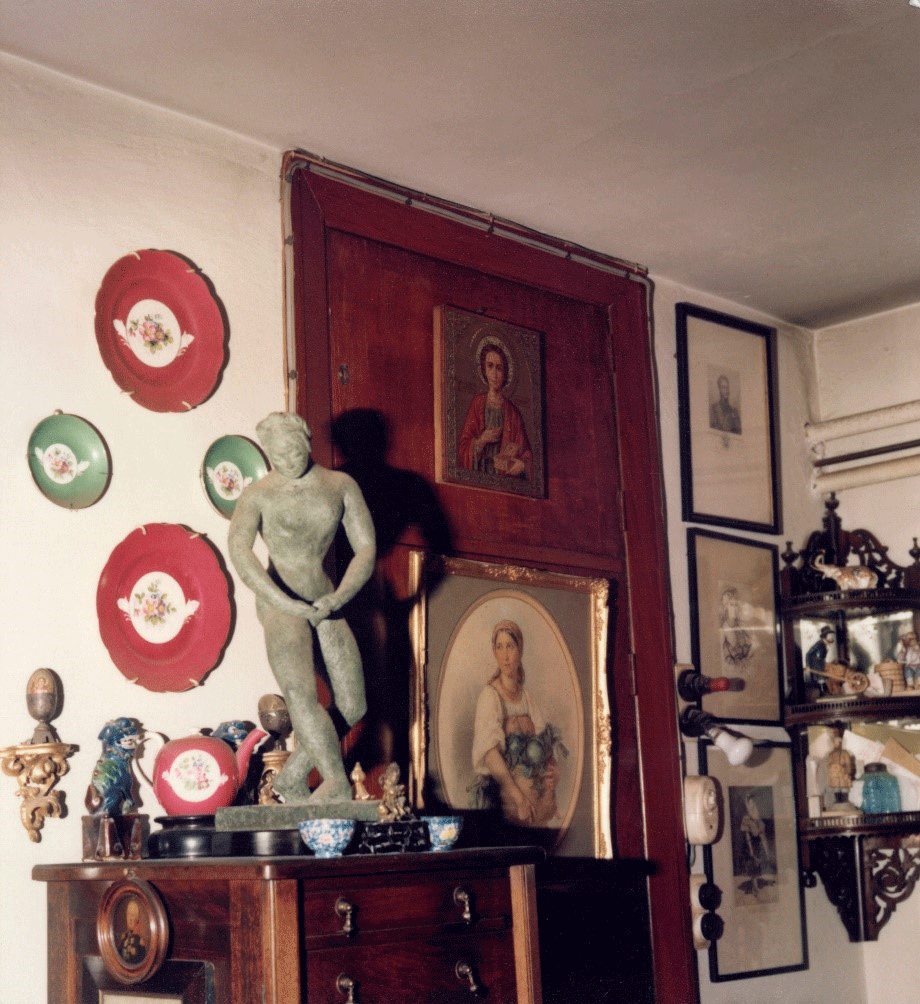
These wall brackets are of interest because they speak to the couple’s passion for collecting beautiful things and their desire to share them with their guests and the wider public. We do not know where they came from or when they were acquired, but photographs of Dorich House show them in several locations.
The wall brackets can be viewed as symbols of Dorich House as a kind of Kunstkammer, a ‘house of wonder’ where collections of works of art and fabulous objects were once displayed for the benefit of the owners and their visitors. They also represent something paradoxical about Dorich House and the Hares’ collections: this twentieth-century dwelling, carefully designed by them in a modernist idiom, was then filled with objects predominately made before or during the nineteenth century.
Where did the couple’s shared passion for collecting come from and why did it form such an important part of their lives? It seems that, at least initially, it was the aesthetic qualities of their treasures that they valued most highly. Dora and others described how the Hares’ life revolved around their love of living with beautiful objects and the sacrifices they made to acquire them.[2] Gordine claimed it was their ‘joy of joys’.[3] The large quantity of objects from Southeast Asia at Dorich House probably came from Dora’s time spent living and working there in the early 1930s. She may also have travelled around the region with Richard before their marriage. However, it was Russian art that was to become the focus of their collecting and was the source of their ambition to establish a museum at Dorich House.
Despite Dora having been born and raised in the Russian Empire, the decision to establish a collection of imperial Russian art and to bequeath Dorich House with its various collections to the nation, complete and as they had lived with them, seems to have come from Richard.[4] According to the packing list of items shipped by Dora from her studio house in Paris, she did not own any Russian objets d’art prior to her move to England in 1935, only household and other practical items, mainly relating to her work as a sculptor.[5]
Richard, ‘a rather nice Englishman’,[6] was a Russian speaker, a diplomat who served in Russia, and an academic specialising in Russian literature who later wrote about Russian art. Richard’s brother believed his interest in the visual arts was ‘entirely due to Dora’.[7] But according to Dora, the idea of establishing a museum came from Richard as an act of love and loyalty towards his country.[8] In 1944, he was promoted to the post of director of the Anglo-Soviet relations division of the Ministry of Information, where a colleague observed Richard became convinced that ‘the English public needed insight into Russia as much as Russians needed knowledge of Britain’.[9] It was around this time that he decided to begin collecting imperial Russian art.[10] The couple’s friends, Dr and Mrs Whittle, also attributed the couple’s enthusiasm for Russian art to Richard, although they were surprised at his ‘passion for Russian things’, possibly given his English aristocratic upbringing as a son of the Earl of Listowel. They described Dora as being enthusiastic about Chinese artefacts, rather than Russian.[11]
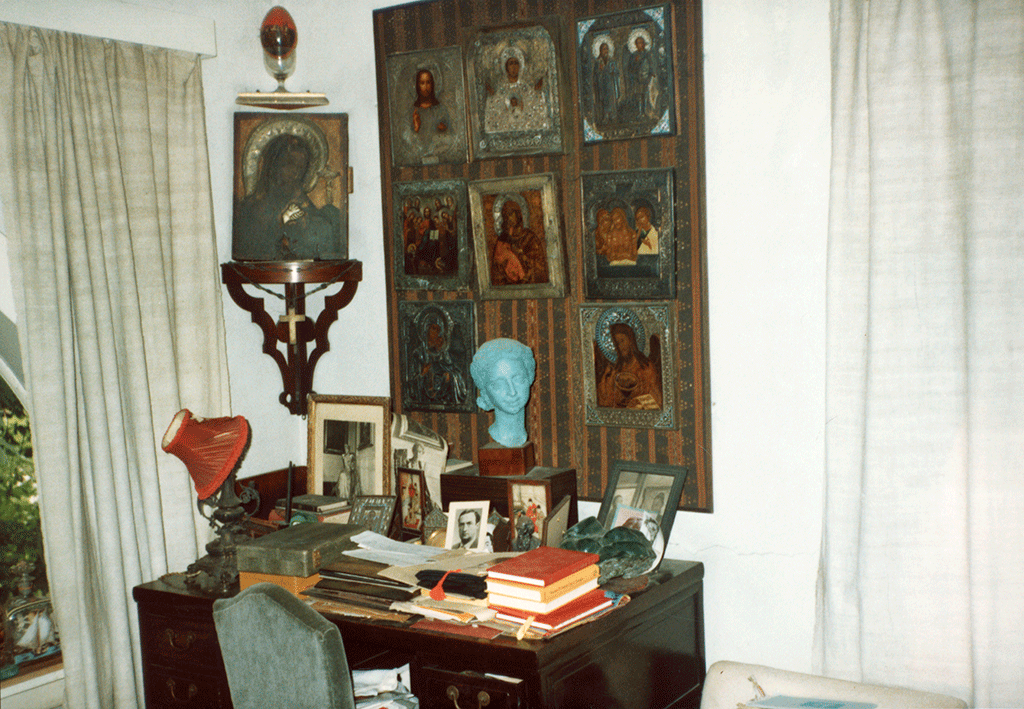
This photograph of what is likely Richard’s desk in the top-floor living room at Dorich House shows a Russian icon atop a wall bracket in the corner of the room. From his knowledge of Russian culture and his six-month-long visit to Russia in 1945,[12] Richard would have been familiar with the Orthodox Christian custom of placing a religious icon in the corner of a room at home, often on a stand with a candle or lamp holder in front to illuminate it during prayer. In Russia this was known as the ‘red corner’; not a political reference but red as in ‘krasnyi’, meaning beautiful. It is thought that Dora may have placed the photo of Richard on this desk after his death, thus completing the transformation of a workspace into a kind of shrine.
Unfortunately, with few exceptions, there is little information about how the Hares acquired their Russian collection, but we know they formed part of a circle of collectors and dealers in England, such as Boris Mylne and Ivor Lloyd,[13] Margot Tracy,[14] A.R. Ullmann,[15] and H.J.L. Viney,[16] with all of whom they traded Russian items. Many of these had been smuggled out of Russia by people fleeing the 1917 Revolution. There are accounts of objects arriving from Paris, where many ex-patriot Russians gathered, and Richard is said to have acquired some whilst serving in Russia.[17] One interviewee describes how Dora and Richard went round junk shops and drove a Bedford van abroad to bring back objects.[18] A more fanciful account describes Dora as being a niece of the Tsar of Russia, who had given her furniture and china from his palaces;[19] an example, perhaps, of Dora’s habit of invention and evasion about her origins and early life as an artist.
Accounts of the rationale guiding the display of the collection vary. According to Dora, Richard’s approach was scholarly and items were arranged ‘in an historical way’, with rooms put together around centuries.[20] One commentator stated, however, that ‘treasures were scattered nonchalantly around the house’,[21] whilst another observed that Russian and Chinese items were arranged to complement each other by virtue of their shape or colour, and not by categories.[22]
Photographs indicate that Dorich House became increasingly cluttered over the years. It is possible that the use of wall brackets to display objets d’art were a later addition to the décor, perhaps necessitated by the need for additional means to display items as the collection grew. Richard and Dora spent the rest of their lives at Dorich House and it is understandable that the arrangement of their acquisitions would alter over time as the size of their collections grew and their priorities and tastes changed. Even so, the wall brackets are at odds with the restrained modernism of Dorich House. The display of ornament favoured by the Hares would not have looked out of place in a Victorian setting.
It seems that the role Dorich House played in their lives changed from its original purposes, which were to provide a studio for Dora, an office for Richard’s studies, and a home for the newly married couple. Their decision to build a bespoke studio home was undoubtedly influenced by Dora’s time in Paris during the 1920s. The city had provided powerful examples of the prestige associated with modernist buildings designed by high-profile architects: the famous Exposition internationale des arts décoratifs et industriels modernes held in 1925 contained many such examples. Dora’s own studio-home in rue de Belvédère in Paris, designed by the pioneering modern architect Auguste Perret (1874–1954), served as a prototype for Dorich House.
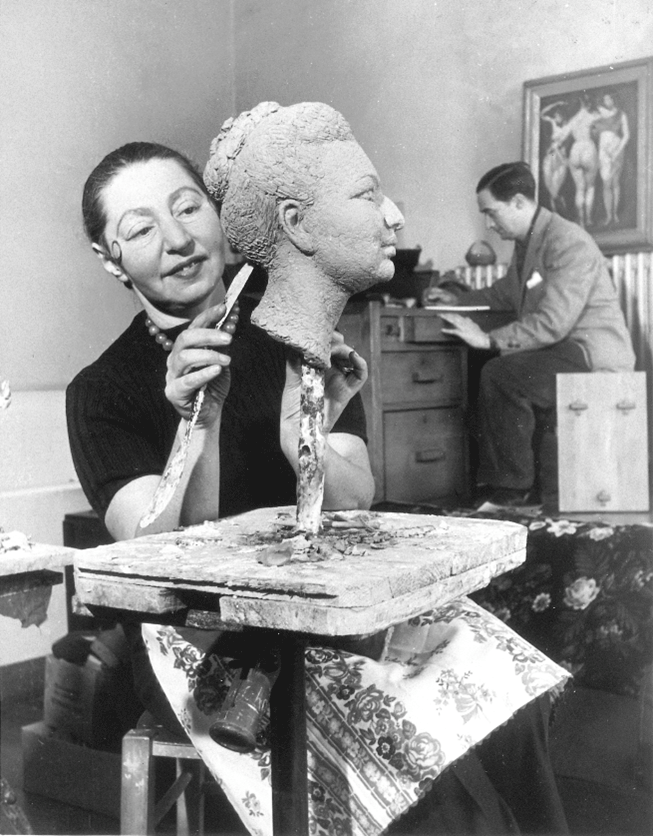
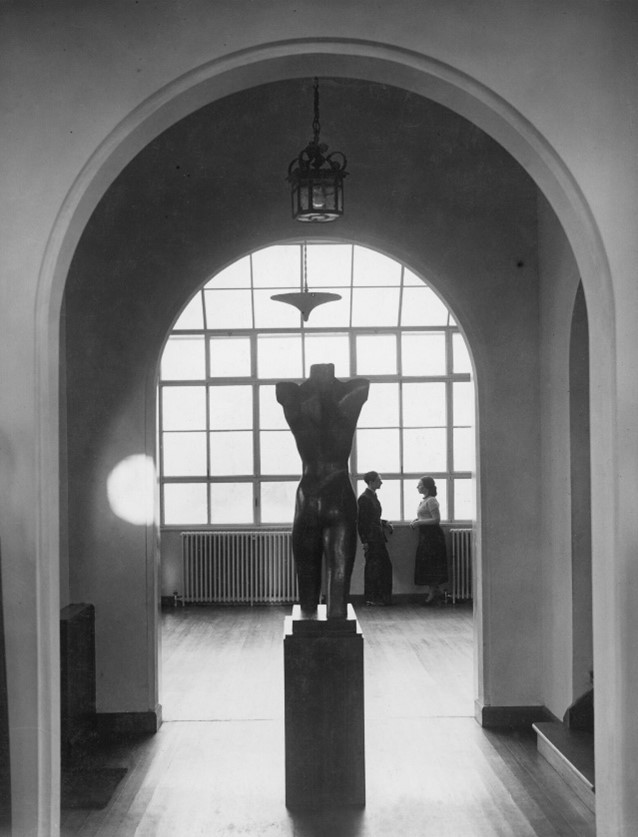
As with her Paris studio home, Dorich House was a projection of Dora’s professional and social standing at a time when she had achieved so much of what she aspired to. It is perhaps no coincidence, however, that as Dora’s reputation as an artist started to wane after the war, so the idea of Dorich House as the repository for Richard’s ambition to create a museum of Russian imperial art began to take shape. Perhaps this explains the contradiction between the style of the house and its contents. What remained constant, however, is the importance of display at Dorich House, whether that be display of a successful female sculptor in her professional and domestic setting; the display of a cultured, well-connected couple with an enviable lifestyle; or the display of treasures and objets d’art from far-off times and places. Either way, the house, named Dorich by Dora and Richard after themselves, served as a theatrical backdrop to their life and work to which the public was invited, either in person or via the many features that were written about them, illustrated by carefully posed photographs.
Perhaps of greater significance, however, is that Dorich House came to represent a powerful statement by Richard and Dora of the primacy of art in their lives. The wall brackets, modest though they are when compared to the Hares’ most rare and valuable possessions, continue to speak to us of their passion for collecting and sharing their treasures.
Nadia Stern
Published as part of the project The Squatter Years: Recovering Dorich House Museum’s Recent Past, funded by the National Lottery Heritage Fund, January 2021
[1] An ‘Expression of Wishes’, signed by Gordine in September 1980 and addressed to the executors and trustees of her will, states it was her ‘earnest wish and desire that both Dorich House and the Collection of objets d’art displayed therein should be kept intact so that it may be available in a permanent exhibition form’. She then listed several cultural organisations she was considering making approaches to.
[2] Interview with Lynn Brua, May 1997; Interview with Trader Falkner, October 1994; ‘Russian sculptor Dora Gordine interviewed on her life and work’, BBC, September 1992; Dora Gordine interview with Tate Gallery, June 1990; Mary Park interview, April 1996; Email from Pat Tarzian, December 2004. All citations in this essay for interviews, letters, telephone conversations and diary entries are held in the Dorich House Museum archives (DGH/9/1 Interviews File).
[3] Interview with Dora Gordine, Tate ref: TAV 734A, June 1990.
[4] Interview with Lynn Brua, May 1997; Interview with Dora Gordine, Tate ref: TAV 734A, June 1990; Interview with Sheila Horsefield 1994.
[5] Maples storage inventory for Mrs D. Gordin Garlick, ex-Paris, 16 June 1936 and 8 July 1936, Dorich House Museum archive.
[6] Interview with Dr and Mrs Whittle, May 2001.
[7] Interview with Lord Listowel, February 1995.
[8] Interview with Dora Gordine, Tate ref: TAV 734A, June 1990; Dora Gordine interview with Tate Gallery, June 1990.
[9] B. Malnick, Slavonic and East European Review, 45.105 (July 1967), 271–72.
[10] Brenda Martin, Biography of Richard Hare, Oxford Dictionary of National Biography,January 2011.
[11] Interview with Dr and Mrs Whittle, May 2001.
[12] Diary references to contacts with Dora Gordine from Mrs Elizabeth Main, May 1945.
[13] Interview with Major Boris Mylne and Ivor Lloyd, April 1995.
[14] Telephone conversation with Margot Tracy, September 1995.
[15] Interview with Dr Suzanne Ullmann, May 1995; Joseph Ullmann, oral-history interview, conducted by Nadia Stern for Dorich House Museum, February 2020.
[16] Interview with Joy and Elizabeth Viney, 2007.
[17] Interview with Lynn Brua, May 1997; Handwritten note by Mrs Francis, 1996; Interview with Mrs Howard, December 1996; Barbara Lewin interview, 1994; Interview with Major Boris Mylne and Ivor Lloyd, April 1995.
[18] Barbara Lewin interview, 1994.
[19] Interview with Finula Kennelly, July 2003.
[20] Dora Gordine interview with Tate Gallery, June 1990; interview with Sheila Horsfield, 1994.
[21] Letter from Angela Rathbone, February 2008.
[22] Email from Laurence Scales, February 2007.

